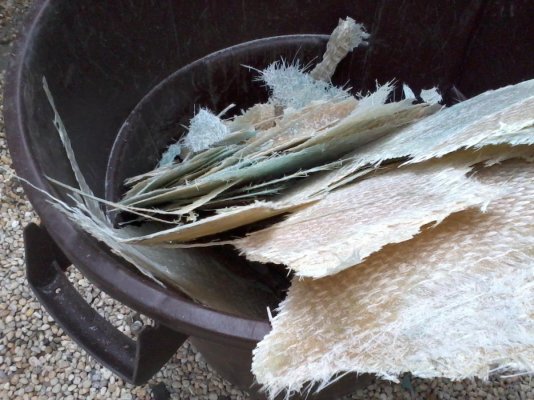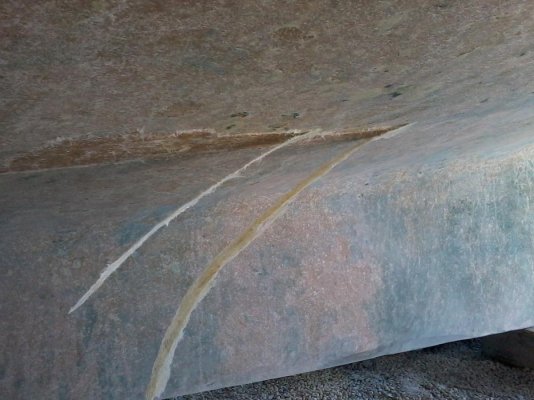bshillam
Guru
- Joined
- May 18, 2013
- Messages
- 801
- Location
- USA
- Vessel Name
- Our Heaven
- Vessel Make
- 1997 4800 Navigator
Good morning,
Yesterday we started our survey and mechanical on an 81 34' Convertible Tolly twin Crusaders. The mechanical so far has gone well. Temps held and were ok through WOT. However we only acheived 3100 RPMs during the sea trial. We believe that this was caused to several things, a fair amount of growth on the shaft and prop as the owner hasn't had the bottom attended to since 2/12. In addition there is a heavy tender on the back of the vessel as well as full tanks and six souls aboard.
However during the survey there were several key things found during the process. Last year the owner had the tanks scrubbed and all fuel polished. In the process the company that completed the work cut the aluminum tanks and put clean out plates on the side of the tanks. To which my surveyor says, "that is illegal." In a gas vessel you can not have any holes in the tanks on the side. No way to easily fix this issue now! The motors have to be removed to replace the tanks or hire someone that can weld the plates now back. Either way it's a safety issue.
The other issue, the deck has "plenty" of moisture. After doing a hammer and moisture reading in the cockpit around the lazerette cover extending about one feet around the piano hinge the moisture reader is pegged. The surveyor believes that the screws holding the hinge have allowed water into the core. In addition on the starboard side just aft of a filler running eight feet back to the salon. It appears it was the owner installed filler that has caused this. There is delamination occurring in both areas. Either way it has to be repaired and would probably cost more to repair the faux teak decking. So we would have to grind the old decking off and apply a non skid. OUCH....
Blisters - the surveyor didn't think they were to much of an issue. His recommendation, watch them each hull out and if changes occur repair. I didn't take pictures unfortunately but I would say there is maybe a total of 100 on the hull? But then again we could have some under the bottom paint, either way he didn't think there was anything to worry about.
Add a handful of other minor issues which I would equate to an older boat. Everything on the list could be repaired to the tune of maybe $500.
I guess my two major concerns at this point is the amount of moisture present in the decking and the extent of the fix needed to properly address the issue. In addition, plates on the gas tank. I asked for his professional opinion on the overall condition and he said better than most in this vintage.
I'd appreciate any feedback at this point. Has anyone had repairs to decking? What kind of cost did you occur? Should we keep looking? Should I expect this kind of condition in a 30+ year old boat and just fix it? We're looking at needing to spend about $8k on canvas as there is none. Now thousands more to resolve the moisture issues. So the boat is climbing to the mid $40s with all the needed work and improvements.
Thanks much for your help!
Yesterday we started our survey and mechanical on an 81 34' Convertible Tolly twin Crusaders. The mechanical so far has gone well. Temps held and were ok through WOT. However we only acheived 3100 RPMs during the sea trial. We believe that this was caused to several things, a fair amount of growth on the shaft and prop as the owner hasn't had the bottom attended to since 2/12. In addition there is a heavy tender on the back of the vessel as well as full tanks and six souls aboard.
However during the survey there were several key things found during the process. Last year the owner had the tanks scrubbed and all fuel polished. In the process the company that completed the work cut the aluminum tanks and put clean out plates on the side of the tanks. To which my surveyor says, "that is illegal." In a gas vessel you can not have any holes in the tanks on the side. No way to easily fix this issue now! The motors have to be removed to replace the tanks or hire someone that can weld the plates now back. Either way it's a safety issue.
The other issue, the deck has "plenty" of moisture. After doing a hammer and moisture reading in the cockpit around the lazerette cover extending about one feet around the piano hinge the moisture reader is pegged. The surveyor believes that the screws holding the hinge have allowed water into the core. In addition on the starboard side just aft of a filler running eight feet back to the salon. It appears it was the owner installed filler that has caused this. There is delamination occurring in both areas. Either way it has to be repaired and would probably cost more to repair the faux teak decking. So we would have to grind the old decking off and apply a non skid. OUCH....
Blisters - the surveyor didn't think they were to much of an issue. His recommendation, watch them each hull out and if changes occur repair. I didn't take pictures unfortunately but I would say there is maybe a total of 100 on the hull? But then again we could have some under the bottom paint, either way he didn't think there was anything to worry about.
Add a handful of other minor issues which I would equate to an older boat. Everything on the list could be repaired to the tune of maybe $500.
I guess my two major concerns at this point is the amount of moisture present in the decking and the extent of the fix needed to properly address the issue. In addition, plates on the gas tank. I asked for his professional opinion on the overall condition and he said better than most in this vintage.
I'd appreciate any feedback at this point. Has anyone had repairs to decking? What kind of cost did you occur? Should we keep looking? Should I expect this kind of condition in a 30+ year old boat and just fix it? We're looking at needing to spend about $8k on canvas as there is none. Now thousands more to resolve the moisture issues. So the boat is climbing to the mid $40s with all the needed work and improvements.
Thanks much for your help!





